Nature can bring strange surprises
Metamorphosis is the title of a story by Franz Kafka about a man who wakes up to find he has turned into a cockroach, and the word means some sort of transformation. Insects all go through different stages before they become the adult form and everyone is familiar with how the caterpillar becomes a chrysalis and then emerge as a butterfly or moth.

Tachinid flies and Monarch Butterfly caterpillars
by BardofEly
Caterpillars should turn into pretty butterflies, all going well, but sometimes this doesn't happen if a parasitic fly gets to them first.
Vine Hawk Moth
A very large caterpillar with a spike on its tail
In my column (in the Tenerife Sun newspaper) I had recently reported about some Vine Hawk moth caterpillars I had rescued from a garden and was looking forward to seeing the adult moth. Sometimes, however, when rearing insects you end up with something very different to what you expected.
There are countless forms of parasitic flies and wasps that lay their eggs on or in caterpillars but the host larval insect looks as if it is healthy until it reaches the later stage in its metamorphosis. Some parasitic species emerge as grubs when the caterpillar is about to change into a chrysalis and others take the situation one step further and are still inside the body of their insect host in the pupa.
So what you finally end up with is not a pretty butterfly or moth but an ugly parasitic fly or wasp. It always reminds me of the scene in the Sci-fi movie Alien where the extraterrestrial creature breaks out of the body of the astronaut it has invaded.
Fortunately, for me I got used to seeing such parasites emerge from caterpillars I had kept as a small boy but I am sure for many people it must be a real nightmare to see this sort of thing happen. Unfortunately this was to be the fate of all the Vine Hawk larvae and it also happened to some Monarch butterfly caterpillars I found.
So I still haven't seen an adult Vine Hawk but I have seen a fly that is a parasite of this species. It was really disappointing but I released the adult parasites, which in their own way have just as much right to life and have an incredible life cycle even if to our eyes it seems gruesome.
The parasite flies go through all the same stages as a butterfly going from egg to grub to pupa to adult. The difference is that unlike a caterpillar they don't eat leaves but must feed on the living flesh of caterpillars they live inside.
Hawk Moths
Books about Hawk Moths
 | Frankiezhou Home Pellucid Hawk Moth Plush Toy, Lifelike Pellucid Hawk Moth Plush Toy 11in, Soft a... Frankiezhou Home Only $22.99 |
 | ZAG STORE - Miraculous Ladybug - Hawk Moth Brooch ZAG STORE Only $29.9 |
 | FRANKIEZHOU Simulation Deaths Head Hawk Moth Stuffed Animal-Yellow 14",Lifelike Death's-Head Hawk... FRANKIEZHOU Only $28.99 |
 | Miraculous Ladybug Hawk Moth Dark Wings Rise T-Shirt Miraculous Only $15.9 |
Tachinid fly
A parasite of caterpillars
The type that killed the caterpillars of the Vine Hawk and the Monarch butterfly was some species of tachinid fly. These parasitic insects look very much like large hairy houseflies.
There are also what are known as ichneumon flies and wasps. The ichneumons tend to be long spindly winged creatures and the females have ovipositor egg-laying tubes, which they use to inject their eggs into caterpillars, and grubs their larvae feed on.
There are countless types of parasites like this and many are used as biological controls of pests that destroy our crops. Many parasites have their own parasites that prey on them and although to our minds it may seem sinister, in reality these insects show how incredible nature is in all its diversity.
But let me tell you more about the Monarch Butterfly caterpillars, which I rescued from a very small Milkweed plant with not enough leaves to feed the three half-grown caterpillars on it and no more plants nearby. The caterpillars would have surely starved if it were not for my good deed.
Ichneumon Wasp
A parasite of caterpillars
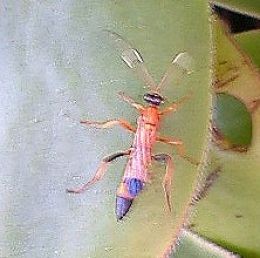 |
Tachinid Fly
A parasite
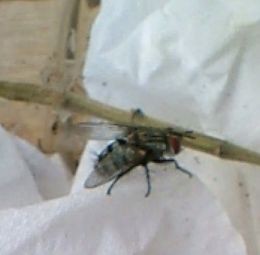 fly |
Milkweed food plant for Monarchs
The Monarch caterpillar
The mother butterfly had found the right plant to lay her eggs on but didn't realise there wasn't enough of it to feed her babies. A mother tachinid fly had also found the Milkweed and the caterpillars on it but I didn't realise this until much later on.
From the three caterpillars that I took home and fed daily with Milkweed one adult butterfly and two tachinid flies were produced. It was a case of third time lucky for the Monarch I thought.
I was thrilled to see the stages of this beautiful insect's life cycle and to get photos of caterpillar, chrysalis and adult. The chrysalis is a real work of Mother Nature's art being an exquisite shade of green with a row of metallic golden spots near the head.
Inside a miraculous transformation is taking place as the body of the caterpillar that was is completely rebuilt into that of the glorious butterfly it will be. And what a beauty the Monarch is with its reddish wings veined with black.
Incidentally, the colours are warning colours that tell would be predators that it is poisonous. The toxins the adult contains were absorbed from the Milkweed the caterpillar ate and this is another form of transformation with the poisons from a food plant being converted into an insect's defence system.
As I watched the butterfly glide away over my house I was thinking about the ugly duckling story, in which the shabby little bird transforms into the magnificent swan. With the tachinid flies it is almost a reversal of this with a made-to-be-beautiful butterfly changed into an unattractive fly, but remember beauty is in the eyes of the beholder and Mother Nature sees very differently to us.
Footnote: First published in the Western Sun, 2006
Copyright © 2012 Steve Andrews. All Rights Reserved.
You might also like
To kill a fly or not? Singer-songwriter Anthony Reynolds chos...The rights and wrongs of killing animals is a very big subject but singer-son...
Stinging Nettles are good for butterflies and good for youStinging Nettles are a food-plant for many caterpillars and an edible weed th...
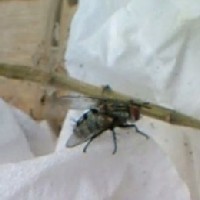

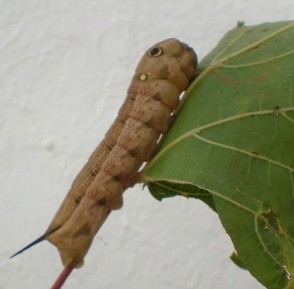
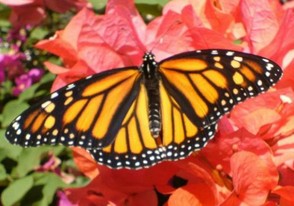
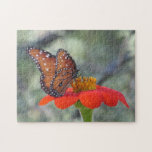


 What to see and do in Icod de los Vinoson 06/28/2016
What to see and do in Icod de los Vinoson 06/28/2016
 Herbs of the Sun, Moon and Planets is the follow up to Herbs of the Northern Shamanon 10/03/2015
Herbs of the Sun, Moon and Planets is the follow up to Herbs of the Northern Shamanon 10/03/2015
 Music for Pagan Weddingson 03/07/2013
Music for Pagan Weddingson 03/07/2013
 Los Silos is part of Tenerife’s Low Island or Isla Bajaon 02/23/2013
Los Silos is part of Tenerife’s Low Island or Isla Bajaon 02/23/2013

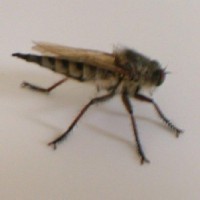
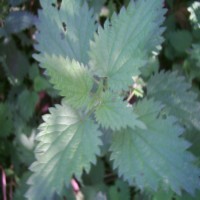
Comments
I had not heard that but it's possible!
I recently read an article that said... hookworms... which are a parasite... actually help people who suffer from Crones disease feel better.
I agree they are beautiful in their own way and I try to see the beauty in all life forms. With some such as heartworms it is very difficult to find anything good about them!
It is very similar to this species too: http://en.wikipedia.org/wiki/Voria
Thanks, Dave, but it is not the species I saw. That was why I chose the photo I used because it was the actual fly that inspired this article.
There are 8000+ species of Tachinid flies...
It could be... they are beautiful in an odd way.
Bard of Ely: Here is a great image of a Tachinid fly. its frm wiki commons and is available to use. http://en.wikipedia.org/wiki/File:Tho...
I don't think so seeing as it was one of the flies that hatched from caterpillars I was keeping. In fact it might well be a species from this genus: http://en.wikipedia.org/wiki/Exorista
I believe your fly photo is a flesh fly... they are attracted to dead things... like bodies.... one of the great tools used in forensic entomology.